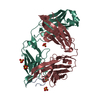+Search query
-Structure paper
| Title | Highly protective antimalarial antibodies via precision library generation and yeast display screening. |
|---|---|
| Journal, issue, pages | J Exp Med, Vol. 219, Issue 8, Year 2022 |
| Publish date | Aug 1, 2022 |
 Authors Authors | Bailey B Banach / Prabhanshu Tripathi / Lais Da Silva Pereira / Jason Gorman / Thuy Duong Nguyen / Marlon Dillon / Ahmed S Fahad / Patience K Kiyuka / Bharat Madan / Jacy R Wolfe / Brian Bonilla / Barbara Flynn / Joseph R Francica / Nicholas K Hurlburt / Neville K Kisalu / Tracy Liu / Li Ou / Reda Rawi / Arne Schön / Chen-Hsiang Shen / I-Ting Teng / Baoshan Zhang / Marie Pancera / Azza H Idris / Robert A Seder / Peter D Kwong / Brandon J DeKosky /   |
| PubMed Abstract | The monoclonal antibody CIS43 targets the Plasmodium falciparum circumsporozoite protein (PfCSP) and prevents malaria infection in humans for up to 9 mo following a single intravenous administration. ...The monoclonal antibody CIS43 targets the Plasmodium falciparum circumsporozoite protein (PfCSP) and prevents malaria infection in humans for up to 9 mo following a single intravenous administration. To enhance the potency and clinical utility of CIS43, we used iterative site-saturation mutagenesis and DNA shuffling to screen precise gene-variant yeast display libraries for improved PfCSP antigen recognition. We identified several mutations that improved recognition, predominately in framework regions, and combined these to produce a panel of antibody variants. The most improved antibody, CIS43_Var10, had three mutations and showed approximately sixfold enhanced protective potency in vivo compared to CIS43. Co-crystal and cryo-electron microscopy structures of CIS43_Var10 with the peptide epitope or with PfCSP, respectively, revealed functional roles for each of these mutations. The unbiased site-directed mutagenesis and screening pipeline described here represent a powerful approach to enhance protective potency and to enable broader clinical use of antimalarial antibodies. |
 External links External links |  J Exp Med / J Exp Med /  PubMed:35736810 / PubMed:35736810 /  PubMed Central PubMed Central |
| Methods | EM (single particle) / X-ray diffraction |
| Resolution | 1.4 - 10.9 Å |
| Structure data |  EMDB-27194: CIS43 Variant 10 bound to pfCSP Class 4  EMDB-27195: CIS43 Variant 10 bound to pfCSP Class 2  EMDB-27202: CIS43 Variant 10 bound to pfCSP Class 1  EMDB-27222: CIS43 Variant 10 bound to pfCSP Class 3  PDB-7sg5:  PDB-7sg6: |
| Chemicals |  ChemComp-SO4:  ChemComp-GOL:  ChemComp-HOH: |
| Source |
|
 Keywords Keywords |  IMMUNE SYSTEM / IMMUNE SYSTEM /  Antibody / Antibody /  Plasmodium falciparum Plasmodium falciparum |
 Movie
Movie Controller
Controller Structure viewers
Structure viewers About Yorodumi Papers
About Yorodumi Papers





